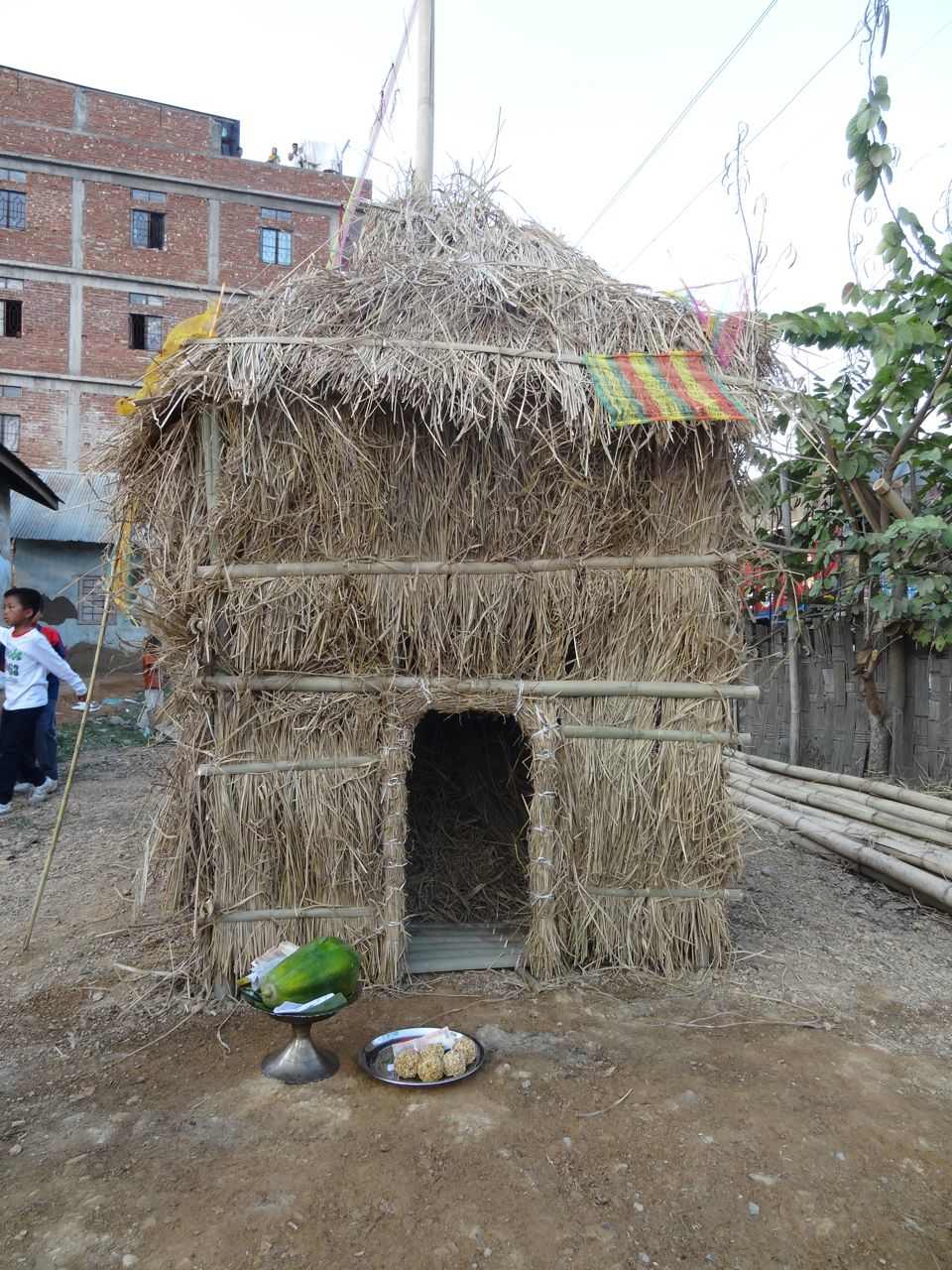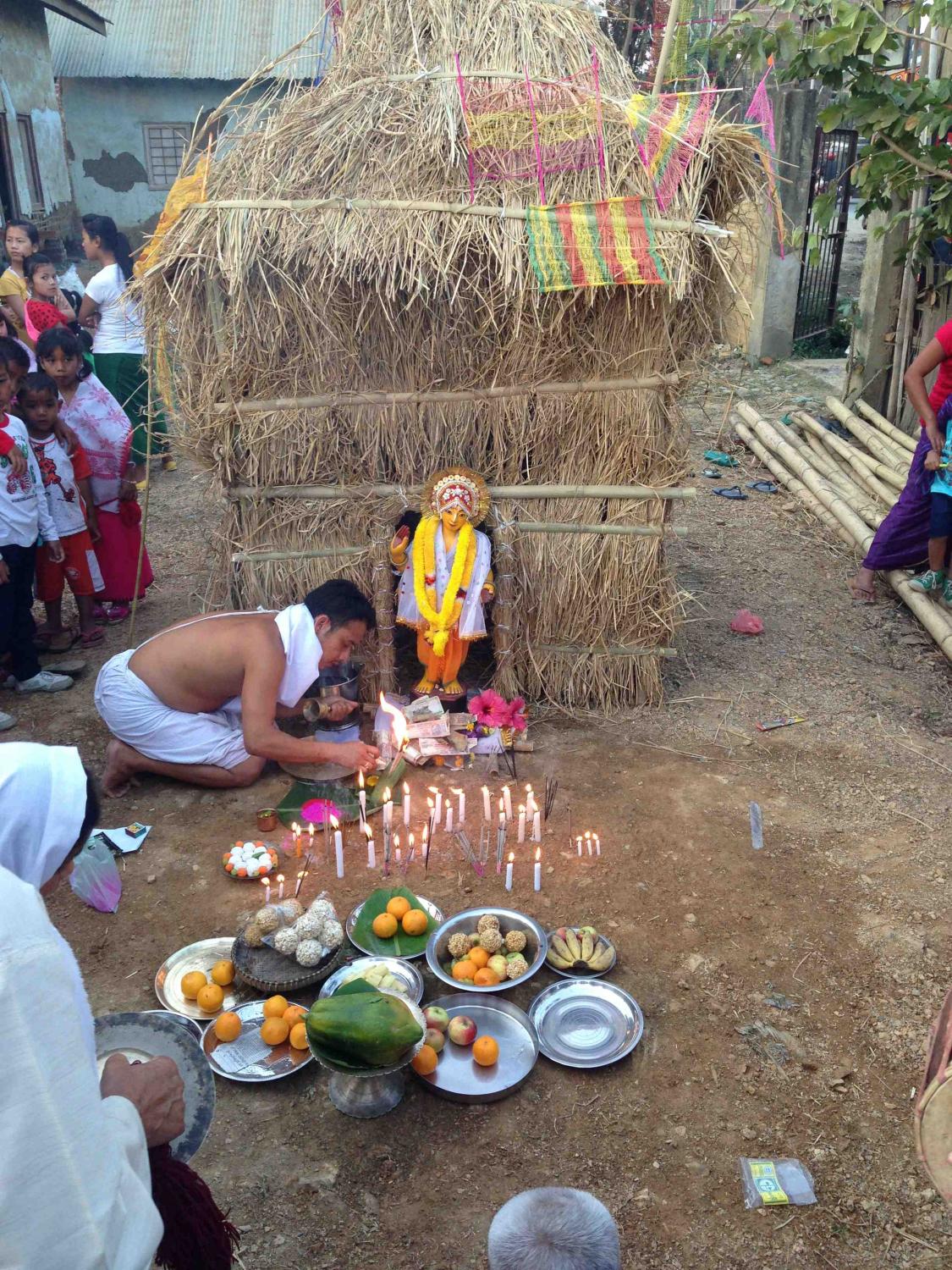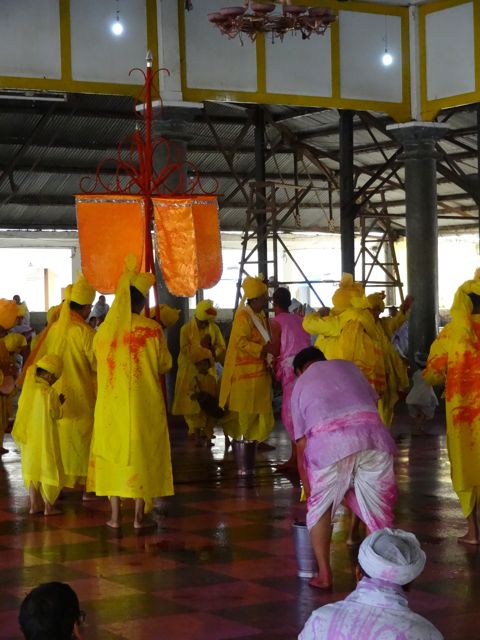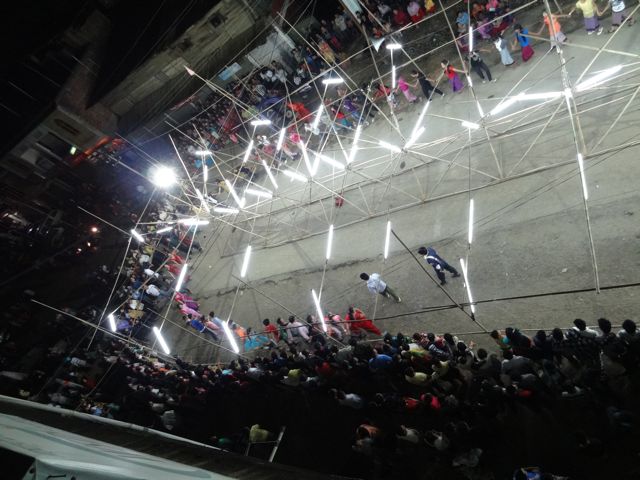Home • Microfinance • Article
Holi: Because one day, one name, and one way to celebrate aren’t enough
April 4, 2013
This past weekend I celebrated Holi for the first time. Holi is known the world around as the Festival of Color for the rainbow of powders that can be seen on every person who sets foot outside their homes during the holiday.
Leading up to Holi, I’ll admit I was pretty excited. It would be nice to see Imphal go a little crazy. I would ask my colleagues at WSDS what I should expect to see, imagining pure mayhem in a typically composed city (for India, anyway). Where could I go to get doused in color? Where should I avoid going to prevent getting doused in color (I wanted to be fully prepared for either extreme)? Does everyone celebrate? What is their favorite part?
The responses to these questions actually just led to more questions. It seems Holi is a mix of two holidays here in Manipur. This combination of two holidays is celebrated for 5 full days instead of the customary 2 or 3 in other parts of India. There are also several elements to the holiday beyond the colors that are more popular to Manipuri people. This is a list of highlights for this region, as I saw it.
1.The burning of the hut
Holi began on Wednesday night with a Hindu tradition: burning a small straw hut. Each locality in Imphal has a designated Brahmin who performs all the rituals and services for that locality. Sometimes there is a temple for him to use, sometimes there isn’t. In the case of Holi, the Brahmin needs a space where a hut can be built and burned safely. For our locality, that space happened to be in the yard of the local government school, which seems as safe a place as any.
 The hut before the Brahmin's preparations
The hut before the Brahmin's preparationsThis hut, I’m told, is large for Imphal. You can imagine, I’m sure, that in a crowded city it’s rare to find enough space to build a hut of this size, let alone burn it down without anything else catching fire.
I am told that out in the villages, the huts can reach the size of small houses, and in very crowded localities in Imphal, they can be as small as a shoebox. In this ritual, size doesn’t matter; it’s all about the sacrificial offerings.
 The Brahmin preparing the hut for burning
The Brahmin preparing the hut for burningThese huts are constructed by the children and teenagers of the locality during the day on Wednesday. When the sun begins to go down, the Brahmin of the locality will come to the hut with a group of men from his temple. A pretty sizeable crowd gathers as he prepares the entrance to the hut with an idol of Holika, the demoness around which the story of Holi is told. The onlookers put various offerings in front of the hut as well, including fruits and flowers, as the Brahmin begins chanting the prayer.
After some time, a little patience, and a lot of incense, the offerings and idol are removed and the hut is lit on fire.
 Burn baby burn
Burn baby burnOnce the hut has burned to the ground, Holi actually begins. Kids run off to throw colors on each other, and start going house to house asking for money to prepare the Holi feasts.
My first question following this ritual was obviously “… but why?” and I assume you are wondering the same.
The history of Holi is long; there are anthropological findings to support the hut burning and color throwing for thousands of years in the countries of India and Nepal, among others. It all stems from a story about a demon, a demoness, and Lord Vishnu.
As the story goes, there was a demon named Hiranyakshipu who aspired to be the most powerful king, powerful enough to seek vengeance on Vishnu, who had killed his brother. This demon had acquired immortality, essentially, from Brahma, so he was immune to fire, as was his sister, Holika. Hiranyakshipu had a son, Prahalad, who, to the demon’s horror, worshipped Vishnu despite his father’s hatred of him. Hiranyakshipu was convinced that he must kill his own son; this was the only way to stop him from worshipping a god he hated so much. The demon tried to kill his son many times; he tried poison (which turned to syrup in his son’s mouth), a stampede of elephants (his son remained unscathed), and drowning (his son was able to breathe in the water), but nothing killed him.
Finally, Hiranyakshipu decided that he must burn his son to death. Knowing that he and his sister were both immune to fire, the demon ordered his sister to sit with his son, Prahalad, on her lap, and he would light them on fire. In theory, she would survive and his son would die in the flames.
However, the opposite happened. Vishnu saved the boy’s life, and instead the demon mother was killed. It is from her name, Holika, that the holiday’s name, Holi, is derived. The hut is burned every year to start the festival as a way to remind Hindus of the greatness of Vishnu, that he saved the boy who worshipped him, despite his own father’s disapproval.
2.The first full day of Holi
After my “uplifting” Wednesday night experience with the hut burning, Thursday morning came around and it was time to go to the Govinda Temple.
As it was the first full day of Holi, revelers were out and about, blasting music out of autorickshaws on their way to various neighborhood parties. I walked with one of my colleagues to the Govinda Temple, the second largest temple in Imphal. It is here that Holi is “kicked off” because, I am told, it is a Krishna temple, and Krishna is basically the God of all Gods.
Over the course of four hours at the temple, I watched group after group of worshippers from different localities within and surrounding Imphal come to the temple. They all waited their turn to enter the main center; once inside, they performed a song and dance that is specifically for Holi. As the song comes to a head, there are designated men with buckets of pink dye that wreak havoc on the revelers, spraying the pink everywhere and on anyone in the vicinity.
 One of many groups to sing and dance and get sprayed in pink
One of many groups to sing and dance and get sprayed in pink
I could have been wise. I could have caught on to this and avoided the scene altogether. When a group of girls covered in paint came up to me, asking for a photo, I could have said no.
Instead, I enthusiastically obliged, and, of course, just as the photographer was clicking our photo, one of the designated men with a bucket and spray tube of pink came up and gave me a hefty spray of pink.
It wouldn’t have been Holi without a little color now, would it?
They say Holi, beyond the burning of the demoness Holika, is a celebration of spring. The colors originally came from all of the natural flowers and plants that finally bloomed in the springtime, and Hindus everywhere thanked Krishna for the change of seasons. This is the reason for the vibrant colors and honestly a nice reminder to stop and pay attention to how lovely the landscape looks after a dry and dusty winter.
3.Yaosang
Yaosang is technically just the Manipuri word for Holi, but the way Manipur celebrates Holi on the whole makes it seem like an entirely different holiday. Until about ten years ago, Imphal seemed like any other Indian city during Holi: colors were thrown, people of all ages were running amok, and businesses were shut down. Today, businesses still close – and for a full five days – but the environment is very tame.
The reason for this is that the government started an initiative, promoting organized athletic activities within localities during the five days of Holi. So now, in Imphal, instead of seeing moms, dads, kids, and grandparents alike throwing colors in the streets, you have to go searching for the action.
This is actually the easy part; from every nook and cranny of the crowded streets you can hear loudspeakers playing music or the announcer’s voice, so following the speakers leads you to an athletic event. During the day, the kids play various sports, and in the evening the adults have their turn.
These games are just within the locality; there’s no inter-locality competition, but it’s fun to see everyone out, spectating, nonetheless. To my delight, it turns out the most popular game for the women is a version of musical chairs, the most competitive of sports.
It is on the outskirts of these games that you see kids sneakily throwing colored powdered on one another; they keep this activity on the down-low since the government has technically asked that no one throw colors anymore.
On top of this, actually, the government has issued an initiative, after what I’ve been led to believe were days of meetings, stating that in the future, Yaosang will only be celebrated for three days instead of five. They say people are tired of the disturbances and tired of being asked for money by the children and teenagers of the locality for both the Holi feasts and Thabal Chongba, the ritual dancing in each locality.
4.Thabal Chongba
Thabal Chongba had been described to me (in detail) at least five times before Yaosang began. Whenever I met someone new, if they asked me how long I’d be here in Imphal, upon learning that I’d be here until May they would proceed to explain Yaosang and Thabal Chongba to me.
I’m not ashamed to admit, then, that I made sure to ask my colleagues and host family every day leading up to and during Yaosang when our locality’s Thabal Chongba would take place. I had gotten so excited from all these stories that I definitely did not want to miss it.
I ended up attending two, so I will happily explain a “typical” Thabal Chongba.
Throughout the day for three days, teenage girls from our locality stood in the road, blocking it down to one lane with wooden benches. They stopped traffic and demanded money from everyone who tried to pass. I actually witnessed a few fights from my window, the girls yelling at drivers who didn’t hand over enough cash.
On the morning of the last day of Holi, long, thick, bamboo poles were piled outside our front door, and construction had begun. By the end of the day, a large, oval bamboo pole skeleton had been built and lights hung on it.
 The bamboo structure is coming along nicely
The bamboo structure is coming along nicelyBy 7 that evening, a sound system was set up and someone was playing the latest Justin Beiber and One Direction jams from a phone. It’s safe to say anticipation and excitement were mounting. Who doesn’t love deafeningly loud boy band music?
From 8 pm until midnight, this is basically what happened.
Some of the girls from the locality, dressed to the nines in their traditional Manipuri wrap skirts and shawls, joined hands and began a sort of line-dancing train inside the oval bamboo structure. At first it was only a handful, jumping to the rhythmic sound of the live band that had shown up to play.
 Thabal Chongba is really gettin' going...
Thabal Chongba is really gettin' going...Over time, more and more girls joined in. In the middle of this circle stood some teenage boys and 20-something men. These are the local boys and men from this locality. They are not allowed to dance with the girls, but rather serve as a type of guard. After the girls have had a few turns around the oval, there is an announcement made that now the dance floor is open. Boys and young men clamor into the ring, inserting themselves in between girls and joining in the dancing train. Everyone knows the steps, which is hugely impressive given what our high school dance floors in the U.S. typically look like.
This tradition was actually started as a sort of matchmaking dance. The girls from each locality would host their own Thabal Chongba, and boys from that locality were not allowed to join in. Instead, only boys from other localities would be allowed to dance with the girls, to promote mingling and meeting between areas. This continues to today, but “body guards” are needed in case the boys from outside localities get too rowdy (this doesn’t seem to happen much, from what I can tell, but you do see the occasional drunk who is quickly kicked out of the circle for sloppy dance moves).
 The most people I've ever seen in one place at one time here
The most people I've ever seen in one place at one time here To sum it up, I will say that all the hype was totally warranted. For a city that is typically so conservative, the government prohibiting the use of color during Holi and shortening the festival by two days, Thabal Chongba offers a night of rowdy revelry. Boys and girls hold hands, kids are running around after dark, and deafeningly loud music is played past midnight. It is pure fun steeped in tradition, a balance Manipur is particularly good at achieving.
PREVIOUS ARTICLE
Loan on your phone! Kiva is rolling out its new mobile lending interface →NEXT ARTICLE
Happy National Volunteer Month from Kiva! →













